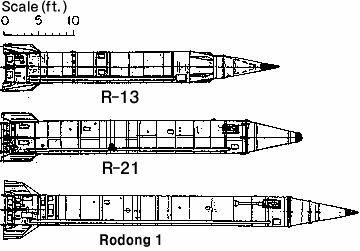|
|
|
 |
|
 Year
Developed: 1993(est.) Year
Developed: 1993(est.)
 Range:
1,000 ~ 1,300km Range:
1,000 ~ 1,300km
 Warheads:
500kg TNT, biological/chemical/nuclear(est.) weapons Warheads:
500kg TNT, biological/chemical/nuclear(est.) weapons |
The ‘Rodong 1’, also known as ‘Scud-D’, was developed through
an overall redesign and revamping of the Scud missile series.
The name ‘Rodong’ was not officially given by the DPRK, but
is a nickname of sorts used by the international community due
to the fact that the missile was test-launched in the ‘Rodong’
village of South Hamgyung Province’s Hamju region. Its development
is believed to have started at the same time as the Scud-C,
and its existence was first confirmed through a U.S. satellite
photo of the missile mounted on a launch pad in 1990 (though
some claim that the correct date is 1989). It was test-launched
successfully in May of 1993, when the missile landed in the
East Sea after traveling a distance of 500km. Mass production
of the ‘Rodong 1` is believed to have started in 1994, and it
seems to have been placed in active service shortly thereafter.
The DPRK’s missile program became an international issue because
of the development of the ‘Rodong 1’. This is because its 1,000km
range enables it to hit Tokyo, Japan as well as Taipei, Taiwan.
The missile suffers from low accuracy, with a margin of error
of about 2~4 km at maximum range.
Its propulsion is believed to consist of four Scud rocket engines
or additional combustion chambers, and its appearance is said
to resemble those of the former USSR’s SS-N-4/R-13 or SS-N-5/R-21
SLBMs (Submarine Launched Ballistic Missile). It can be equipped
with TNT as well as biological/chemical warheads. It is presumed
that the DPRK received assistance in developing the ‘Rodong
1’ from scientists with the USSR’s Makayev SLBM program who
designed the Scud missile. |
|
 |
|